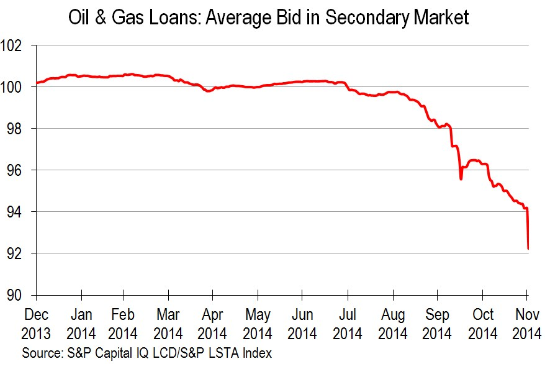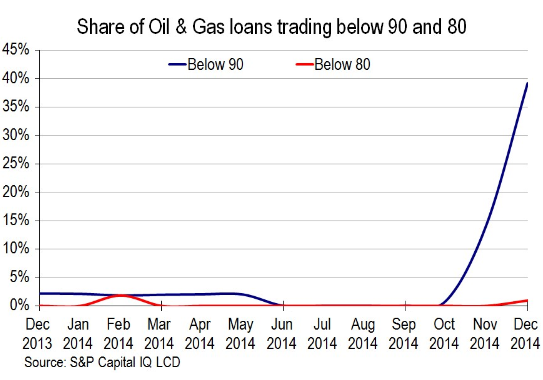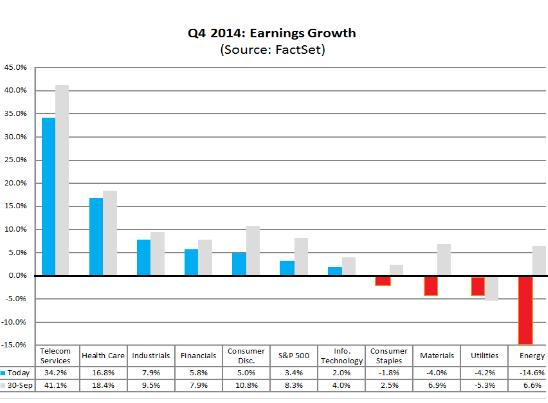The price of oil has plunged nearly 40% since June to $65.63, and junk bonds in the US energy sector are getting hammered, after a phenomenal boom that peaked this year. Energy companies sold $50 billion in junk bonds through October, 14% of all junk bonds issued! But junk-rated energy companies trying to raise new money to service old debt or to fund costly fracking or off-shore drilling operations are suddenly hitting resistance.
And the erstwhile booming leveraged loans, the ugly sisters of junk bonds, are causing the Fed to have conniptions. Even Fed Chair Yellen singled them out because they involve banks and represent risks to the financial system. Regulators are investigating them and are trying to curtail them through “macroprudential” means, such as cracking down on banks, rather than through monetary means, such as raising rates. And what the Fed has been worrying about is already happening in the energy sector: leveraged loans are getting mauled. And it’s just the beginning.
This monthly chart by S&P Capital IQ’s LeveragedLoan.com shows the leveraged loan index for the oil and gas sector. Earlier this year, when optimism about the US shale revolution was still defying gravity, these loans were trading at over 100 cents on the dollar. In July, when oil began to swoon, these loans fell below 100 cents on the dollar. The trend accelerated during the fall. And in November, these loans dropped to around 92 cents on the dollar.
How bad is it? The number of leveraged loans in the oil and gas sector trading between 80 and 90 cents on the dollar (blue line in the chart below) has soared parabolically from 0% in September to 40% now. These loans are now between 10% and 20% in the hole! And some leveraged loans are now trading below 80 cents on the dollar (red line):
“If oil can stabilize, the scope for contagion is limited,” Edward Marrinan, macro credit strategist at RBS Securities, told Bloomberg. “But if we see a further fall in prices, there will have to be a reaction in the broader market as problems will spill out and more segments of the high-yield space will feel the pain.”
Oil and gas stocks are bleeding: the Energy Select Sector ETF (XLE) is down 21% from June; S&P International Energy Sector ETF (IPW) down 29% from early July; and the Oil & Gas Equipment & Services ETF (XES) down 42% from early July.
Smaller drillers are in trouble. All of them had horrific single-day plunges, some over 30%, on “Black Friday” after OPEC’s Thanksgiving decision to keep production quotas at 30 million barrels per day. By now, “Black Friday” has acquired an entirely different meaning in the oil patch than its classic meaning in retail. Traders who tried to catch these stocks have gotten their fingers sliced off since then:
- Goodrich Petroleum -88% since June.
- Energy XXI -86% since June
- Sanchez Energy -78% since June.
- Oasis Petroleum -75% since July.
- Triangle Petroleum -71% since June.
- Stone Energy -70% since April.
- Clayton Williams Energy -62% since May.
- Callon Petroleum -61% since June.
- EP Energy -60% since June.
These are the very companies that benefited during the crazy good times from yield-desperate investors who’d been driven to obvious insanity by the Fed’s interest rate repression. These investors – such as your bond mutual fund or your pension fund – loaded up on energy junk bonds and leveraged loans. Because it was so easy and cheap, companies loaded up their balance sheets with debt. Now these balance sheets are over-leveraged teetering constructs. And the Fed-inspired financial house, where all risks have been eliminated by QE Infinity and ZIRP, is rediscovering risk.
Turns out, the Fed, so ingeniously prolific in buying financial assets to inflate their prices, can’t buy oil to inflate its price.
Companies in the sector are now facing a harsh reality: crashing revenues and earnings. Some of them are going to have liquidity problems. Unless a miracle happens that will goose the price of oil pronto, there will be defaults, and they will reverberate beyond the American oil patch [read… Saudi Arabia Declares Oil War on US Fracking, hits Railroads, Tank-Car Makers, Canada, Russia; Sinks Venezuela ].
But even the 43 largest, most diversified players in the energy sector that are part of the S&P 500 are grappling with the new reality: analysts chopped earnings estimates by 20.5% since September 30, according to FactSet. If this is the final decline for the quarter – though the chopping is likely to continue – it will be the worst decline in EPS estimates since the first quarter of crisis-year 2009.
As of Friday, analysts expected the energy sector to report a 13.7% drop in revenues. At the beginning of the quarter, they’d expected a decline of only 1.7%, though oil prices had been plunging for three months. And they now expect a 14.6% swoon in earnings, as opposed to the 6.6% gain they still saw at the beginning of the quarter. This chart by FactSet shows the ugly reversal of their EPS expectations (red bar on the far right) – and just how far they lagged behind when the quarter began:
All of the energy companies in the S&P 500 got their EPS estimates decimated, even the biggest ones: Exxon Mobil by 20%, Chevron by 25%, Hess by 47%, Murphy Oil by 50%, and Marathon Oil by 63%.
Exxon CEO Rex Tillerson told CNBC that his company could get by with $40 oil by refocusing on basics, “watching your cash, watching your investment decisions, being very disciplined about everything….” But he didn’t elaborate for how long. Lesser companies, particularly those with over-leveraged teetering balance sheets, may run out of options, or cash, long before then.
The effects are already being noticed as a desperate feeding frenzy takes its course. Read… Corporate Bond Bubble Comes Unglued at the Bottom, Investors Begin to Bleed
Enjoy reading WOLF STREET and want to support it? You can donate. I appreciate it immensely. Click on the beer and iced-tea mug to find out how:
Would you like to be notified via email when WOLF STREET publishes a new article? Sign up here.
![]()





Hallo Wolf,
what do you think? In my opinion in the next few months it will be a good time to invest in oil companies with high quality and not to much debt. For example the norwegian Statoil ASA.
http://www.gurufocus.com/stock/STO&summary
In the oil service business, I think Helmerich & Payne looks pretty good. But wee need a time of patience.
Best regards from Berlin/Germany
Egbert
I think you’re right to include the matter of time in your question (“next few months”). Among the big questions are: when will oil stop dropping, when will it start rising again, and which companies will survive the shakeout without handing their equity over to their creditors (as would happen in a bankruptcy). If history is any guide, there could be some surprises involved in those answers. But people who get this right will make a lot of money :-)
We know the marriage between KSA and USA has soured. It’s purported the latter has stolen the former’s gold from Swiss banks. KSA has also been cozying up with China. I wonder if the two of them hatched this plan bringing enormous benefit to China and retribution for KSA.
To all who are watching the oil and gas stocks, you would be wise to first determine whether this is an expected “Minsky Momemt” .
Few months seems a bit on the short side of things. What we are witnessing right now in the oil market is a massive miss-allocation of resources. For the past five years the creation of artificial demand has driven up the price of oil. This in turn allowed companies to go after more expensive oil. To fund these projects these companies took on massive amounts of debt. This debt has only been sustained through artificially low interest rates. In short, five years of artificially high oil prices have led companies to overproduce oil as well as debt and with the price of oil collapsing 40% this year it could take a year or two before the full damage is realized.
Think you nailed it, and anyone assuming this will be over in a few months should step back and have a good look at the big picture first.
Thinking out loud… How much contagion will there be? Will the junk bond collapse in oil spread to other junk bonds? Will the EPS decline cause a general decline in the overall markets? Will the FED, who currently seems to be encourage that the markets and jobs are positive, have to back down and rescue the oil speculators and the banks again? Will the Republican House go along as they are supported by resource producers yet the banks support the Democrats in general?
Sitting on the edge of my chair (Not) waiting for the next episode of drama on the Potomac.
Here’s another take on this whole thing.
1) What if George Bush’s visit to Saudi Arabia back in 2007 (and just prior to the Great Recession) was to implore them to hold oil price UP. Press reports were the opposite but with an impending deflationary depression, Bush may have had to go asking to ensure oil didn’t drop and support the spiral. Oddly, oil went ballistic sometime after that; perhaps speculators got wind of the drift?
2) What if all this time the Saudi’s have been playing this game for the US; holding prices up to prevent deflation from really taking hold? After all, oil is the one commodity that is priced into virtually everything in our economy.
3) What if the Saudi’s finally got pissed enough that the US was using their favor to develop their own oil resources (at the higher price point); as well as some of the obvious missteps in the Mid-East (ISIS, Iran, etc.)?
Now all that being said, even if the Saudi’s allow prices to stay low, I believe the Fed will rescue the US fracking companies. I see all of that as a national strategy to try and become less energy dependent (started by Bushee and carried on by Obamba). Perhaps in possible preparation for problems with the dollar, reserve currency, petro dollar, etc.
We’ve entered a whole new era of moral hazard in our economy. What was done post 2009 will set the baseline for what the government will do to prevent collapse. Support for fracking could be done covertly through Fed member banks and even if it got public, could be promoted on national security basis for reasons above.
O boo hoo. I cry every night over their loss. God’s judgment is upon the greedy.
Isn’t it funny how we all sit around and speculate about the motives, politics, and the possible outcomes etc without ever questioning the base of the system. The fiat currency that is the Petro dollar. When it comes down, let’s hope it’s for good, and it’s replaced by a resource managed system, one designed to maximize the utility of, and minimize the consumption of our limited resources. Capitalism will always defeat communism, socialism, and facism because it’s more efficient, but will inevitably collapse because it’s predicated on perpetual growth – which will eventually lead to resource exhaustion.
There isn’t going to be any miracle.
The same folks who are needed to push up the price of crude are on food stamps, have lost 35% of their wealth in Japan, have ‘slowed’ in China; are mired in depression in southern Europe (and in northern, eastern and western Europe as well). Because a car cannot be paid for by driving the car, the world is bankrupt x its 1 billion cars.
Driving the car does not pay for the fuel, or the roads or any of the rest of the associated junk including the massive, intrusive governments that everyone loves to hate. What pays is hundreds of trillion$ of debt … that cannot ever be retired.
The costs of education, Obamacare, wars, infrastructure maintenance and entertainment (drugs) have to be borne by citizens who must borrow to bid the price of petroleum products. The customers cannot borrow, as a result they are insolvent. Credit breakdowns caused by driller defaults will smash the customers even harder … the bid will shrink leading to more defaults in a vicious cycle: this is ‘Energy Deflation’ (think of Irving Fisher’s debt deflation model). The price will decline to the level where use (waste) of petroleum is deemed to offer a return … Unfortunately, there are no returns! Petroleum is simply wasted for entertainment and status. No returns and no miracles, either. There is nowhere for oil prices to go but down, nowhere for customers to become but destitute. By refusing to institute voluntary stringent conservation we are set to experience ‘Conservation by Other Means™’ less use by way of war, national ruin, credit and currency crises.
What is underway is serious as a heart attack. Saudi Arabia has nothing to do with this as they are fully committed to high-priced crude to pay welfare to their millions of unemployable citizens. Ditto the rest of OPEC. There is also no glut of crude as flow of fuel supplies is 6- or 7 million barrels per day below pre-2005 trends. This ongoing shortage does not cause price to increase, it reduces customer purchasing power, instead. This is what the economists miss: oil prices will drop … to test the 2009 low … and the price will still be unaffordable, there will be price pressure toward even lower prices.
Tighten your chin straps: the next phase of the Great Financial Crisis has begun …